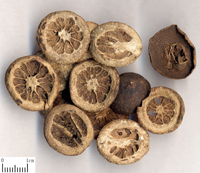|
枳实系列
Chapter 14. Zhishi series
Zhishi is the young fruits of plant Citrus aurantium L.
In TCM, it works to break the accumulated mass in the body,
which in nature belongs to air, gas, or phlegm. It mostly works
to remove the fullness due to the accumulation of such air- and
phlegm-type stuff. This is different to the Dahuang, that works
to remove the block or accumulation of solid stuff, such as
hosting stool.
Zhishi is similar to the function of Hopou.
Both works to remove fullness and bloating feeling of the body.
However, Zhishi belongs to Cold herb and Houpo, a warm
herb. In clinic, they are usually used together, so that either
the Cold accumulation or a Hot accumulation can be released. In
<< Shang Han Lun >>, there are eight formula that used these two
herbs together and only one formula used only Houpo along.
 Zhishi
Zhishi
(1).
枳实白术汤方
Zhishi Baishu Tang
枳实七枚,白术二两
Zhishi 7 badges, Baishu 30 gram
右二味,以水五升,煮取三升,分温三服,腹中耎即当散也。
Add the herbs and 1250 ml water into a herbal pot. Bring to boil
and keep in mild boiling until there is 750 ml herbal tea left.
Drink one third of the tea each time, three times a day.
心下坚,大如盘边,如旋盘,水饮所作,枳实白术汤主之。(以坚大而不满痛,是为水气虚结,未可下也。)
If the upper abdomen is hard when touched, and it is big as a
big plate, it is due to the Water disease. Use Zhishi Baishu
Tang. This condition also belongs to the Lishui condition, but
the abdomen is hard and big in the upper abdomen, suggesting a
hollow stick condition,
not a fullness and pain condition, e.g. not a solid
fullness condition, so the bowel-cleansing therapy should not be
used, but the Zhishi Baishu Tang here to break down the hollow
mass.
注意:气分,心下坚,大如盘,边如旋杯,水饮所作,桂枝去芍药加麻黄附子细辛汤主之。
With the Qi harshness disease, the person feels hard and solid
in the upper abdomen, the stomach enlarged as a big plate there.
This is due to Water Xieqi accumulation there. Use Guizhi qui
Shaoyao, jia Mahuang Fuzi Xixin Tang
(2).
枳实芍药散
Zhishi Shaoyao San
枳实(烧令黑,勿太过),
芍药等分
Zhishi (burn to black in color), Shaoyao, equal amount.
右二味,杵为散,服方寸匕,日三服。并主痈脓,以麦粥下之。
Prepare the herbs into powder. Drink 1 gram each time, three
times a day. This herbal formula can also be used for the
treatment of abscess, drinking barley soup to help swallow.
产后腹痛,烦满不得卧,枳实芍药散主之。
If the woman has pain in abdomen after delivery, feels annoyed
and fullness in abdomen, and feels hard to fall into sleep, use
Zhishi Shaoyao San.
师曰:产妇腹痛,法当以枳实芍药散。假令不愈者,此为腹中有干血着脐下,宜下瘀血汤主之。亦主经水不利。
Master: for woman after delivery has pain in stomach, Zhishi
Shaoyao San should be used. If it does not work, it suggests the
presence of dry blood mass adhering under the naval. In this
case, change to Xia Yuxue Tang.
(3).
排脓散
Painong San
枳实(十六枚)
芍药(六分)
桔梗(二分)
Zhishi 16 badges, Shaoyao 48 gram, Jiegen 16 gram.
右三味,杵为散,取鸡子黄一枚,以药散与鸡黄相等,揉和令相得。和服之,日一服。
Prepare the herbs into powder. Mix it with same amount of
chicken yolk. Eat the mixture once a day.
(4).
枳实薤白桂枝汤方
Zhishi Xiebai Guizhi
Tang
枳实
四枚,厚朴
四两,薤白
半斤,桂枝
一两,栝蒌实(捣)一枚
Zhishi 4 badges, Houpo 60 gram, Xiebai 125 gram, Guizhi 15 gram,
Guolushi 1 badge.
右五味,以水五升,先煮枳实、厚朴,取三升,去滓,内诸药,煮数沸,分温三服。
Add the Zhishi and Houpo and 1250 ml water into a herbal pot.
Bring to boil and keep in mild boiling until there is 750 ml
left. Remove the reside, add the remaining herbs in, continue to
boiling for 10 min. Drink one third of the tea each time, three
times a day.
胸痹,心中痞气,气结在胸,胸满,下逆抢心,枳实薤白桂枝汤主之,人参汤亦主之。
For person with the Xiongbi disease, if he feels fullness in the
upper abdomen and in the chest, feels as there is air pushing to
the heart, use Zhishi Xiebai Guizhi Tang, or use Renshen Tang.
|


